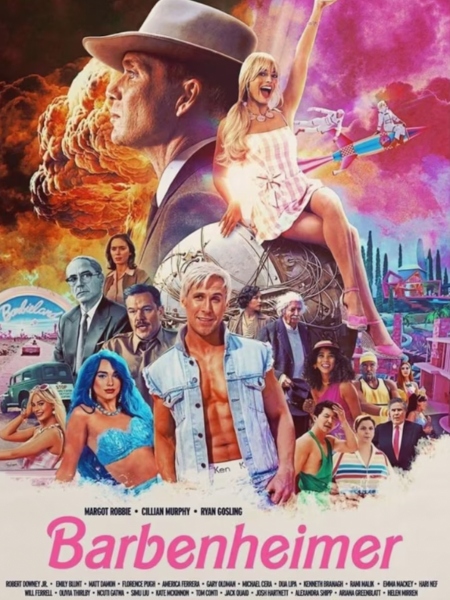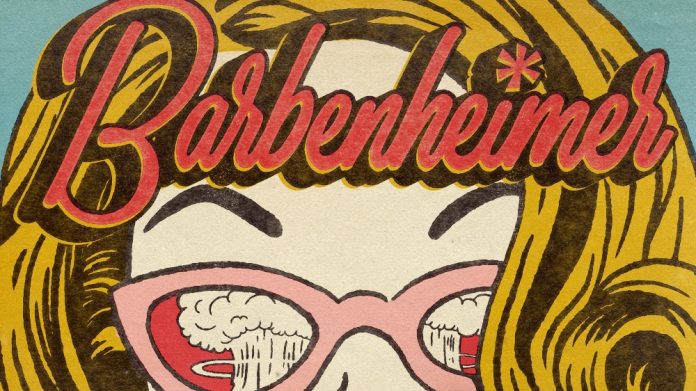If you visited a movie theater this past weekend, you likely found yourself lost in a sea of pink and black outfits — or maybe you even wore one yourself.
Greta Gerwig‘s Barbie, based on the iconic doll from Mattel, took the top spot at the domestic box office, where it earned an astounding $162 million, while Christopher Nolan‘s period drama Oppenheimer, about the theoretical physicist who created the atomic bomb, claimed second place with $82.4 million. Both overperformed well beyond expectations, especially Barbie, which opened to $337 million worldwide. (Read Edward Douglas‘ in-depth breakdown of last weekend’s box office here.)
While Gerwig and Nolan surely have their share of loyal fans, the viral Barbenheimer campaign that fueled both films on social media is largely to thank for their box-office success. AMC Theatres reported on July 10 that 20,000 same-day tickets were sold for the Barbenheimer double feature, and within a week, America’s largest chain reported that the number doubled to 40,000 advance ticket sales — that’s for both movies on the same day.
While studio executives no doubt deserve credit for backing Gerwig and Nolan’s creative visions, it’s the employees in their marketing divisions who went above and beyond here. Barbie had an overall budget of $145 million, while it reportedly had a budget of around $100 million for marketing alone. All of the global brand collaborations from Airbnb — which literally brought the Malibu Barbie Dreamhouse to life — to the various food and retail partnerships were apparent. But did any of those activations go viral like the first shots of Margot Robbie and Ryan Gosling as Barbie and Ken did when they were first unveiled a year ago at CinemaCon, or the behind-the-scenes photos that leaked of the pair in neon pink and yellow outfits while filming in Los Angeles? Those were practically ubiquitous on social media.

Universal’s marketing campaign for Oppenheimer was more minimalist in comparison to Warner Bros. for Barbie — the studio utilized a billboard campaign featuring a live digital clock counting down the days before its release — but nothing moved the needle like social media did when users began pairing Oppenheimer as an ironic double feature with Barbie, though one that makes more thematic sense once you’ve seen both films. As such, Barbenheimer might’ve been the best possible thing to happen to Nolan’s film, even beyond landing stars like Matt Damon and Robert Downey Jr. or locking down IMAX screens ahead of Tom Cruise‘s latest Mission Impossible sequel.
Speaking of which, both Barbie and Oppenheimer performed far better than some of Hollywood’s recent franchise titles, such as Indiana Jones: The Dial of Destiny and Mission: Impossible – Dead Reckoning Part One, which posted underwhelming openings. Some might chalk that up to sequel fatigue, but something about Barbenheimer clearly resonated with people online — it became a pop culture event you couldn’t afford to miss out on because social media demanded that you have an opinion about it.
While the domestic box office has been slow to recover from the impact of the pandemic, and consumers are still cutting back on entertainment costs amid inflation and economic uncertainty, moviegoers will clearly still come out for movies that they really want to see. According to PostTrak research, 65 percent of Barbie‘s audience were women, while 40 percent of ticket buyers were under the age of 25. Meanwhile, Oppenheimer skewed more male, with 62 percent of men making up the audience, 65 percent of which was over 25. Meanwhile, around 32 percent of the audience for the three-hour film was between the ages of 18 and 24. Those are solid demographics any way you look at them, but let’s take a closer look at social media.
The hashtag #barbenheimer has more than 400 million views on the Gen Z-popular social media platform TikTok, which is brimming with user reviews of both movies. It wasn’t brainstormed in a conference room in Burbank, it was created by social media, which then ran with the concept — one that the studios later embraced. Many TikTokers wore themed costumes or Barbenheimer t-shirts, some of which they made themselves, though third-party sites certainly got in on the action and embraced the craze. One woman went viral over the weekend for a custom-made dress, which transformed from pink to black as she moved from Barbie to Oppenheimer, both of which were awash in online memes in the run-up to their releases.

While there hasn’t been a weekend this year with a match-up as massive as Barbie and Oppenheimer, there have been other examples of box office successes fueled by organic viral marketing driven largely by young fans on social media. Universal’s M3GAN, which took the number one spot during its debut weekend earlier this year, saw the titular doll become an internet celebrity of sorts on social media, while Paramount’s horror movie Smile also crushed expectations at the box office thanks to its creepy viral marketing that was spotted at various baseball games. There was also last year’s #gentleminions TikTok trend that saw teens donning suits and formalwear to see Minions: The Rise of Gru, which partially fueled its success at the box office.
And though it caters to a much different and more conservative audience, Angel Studios’ faith-based movie Sound of Freedom, which stars Jim Caviezel as a former government agent who goes on a mission to save hundreds of children from sex trafficking, also surpassed expectations thanks to its word-of-mouth and “pay it forward” marketing tactic in which a message at the end of the film asks viewers to buy an extra ticket “for someone who would not otherwise be able to see” it. That move has resulted in audiences buying extra tickets to give to friends and family, and to date, the film has earned a total of $124 million at the domestic box office against a budget of just $14.5 million.
It might not be easy for studios to replicate what happened with Barbeheimer in an authentic way, and given the shift in release dates on this year’s film calendar due to the WGA and SAG-AFTRA strikes, Hollywood might not see a major weekend like this for a long, long time. But when, or if, business continues to run as usual in the future — whenever that may be — studios should take note of the power of social media and its ability to turn certain movies into genuine events. It has to be organic, but still, they’d be wise to invest in their social media marketing teams to help build hype around movies well-suited for success online.



